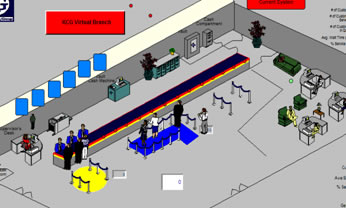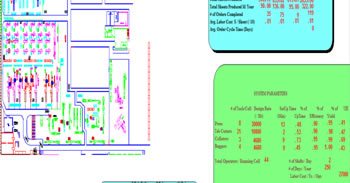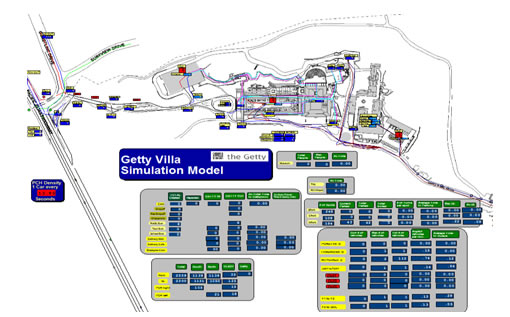Simulation and Modelling
Our simulation modelling methodology enables decision makers to reduce costs, increase system capacity, accelerate cycle time and improve customer service and can be used in
- Transportation system design
- Logistics support analysis
- Supply chain optimization
- Supporting 6 sigma projects
- Evaluating new equipment and processes
- Improving sales and operations planning
- Capacity analysis and improvement
- Identifying and minimizing bottlenecks and constraints
- Resource allocation and cost reduction
- Reducing inventory
- Warehouse optimization
- Cycle-time reduction
- Distribution requirements planning optimization
- Airport baggage handling and security
- Event logistics analysis and planning
- Emergency preparedness
“Simulation modelling can be used as a separate tool or can be used in conjunction with Lean Six Sigma.”
Within the analyze and improve stages of the DMAIC methodology, or the analyze and design stages of the DMADV methodology, simulation is a powerful software tool because of the following value and benefits it provides:
- Simulation takes into account process variances, uncertainties and interdependencies
- Simulation can test many alternative solutions quickly and easily
- Models can be developed with little risk and no disruption to existing processes
- Simulation takes the subjectivity and emotion out of decision making
- Animation features make simulation a good tool to help sell others on the best solutions
- Reusable models encourage continuous improvement
- Impact on upstream or downstream customers/operations/processes can be considered
Value of Simulation for Lean – what would it be Worth if:
- Your organization realized a Lean goal one month sooner on every value stream mapping project?
- Your team could avoid 10{ec62db246b4cc8436630f3696621ce1bb108d53f1bac84e2df725bfb7ce384fc} of the downtime associated with Kaizen events?
- You could quickly predict the impact of a Lean initiative on key metrics prior to implementation?
- You could gain better visibility and predictability into all the Lean projects and allocate precious resources more effectively?
Benefits of Implementing Lean with Simulation
- Enables rapid adoption and full life cycle support of Lean.
- Predict and quantify positive (or negative!) systemic impact of suggested improvements.
- Accelerate a single event and the whole initiative.
- Reduce risk and focus on events with opportunities to provide the greatest positive impact.
-
Understand the potential impact on the “corporate or strategic” enterprise value stream.
Simulation modelling is a powerful analysis tool for reducing business costs, increasing organizational capacity, accelerating cycle times and improving customer service. Our continuous process improvement solutions have created more than US$ .5 billion of value, and typically show returns of over 10 times the investment in a just a few months.
Customers apply the simulation modelling based solutions to solve complex applications including:
- Reducing order-to-cash cycle time
- Supporting 6 sigma projects
- Accelerating new product development
- Adding advanced analytical capabilities to ERP systems
- Optimizing supply chain and logistics networks
- Improving customer service with lower cost
- Optimally designing call centers
Case 1 – Service Industry (Retail Banking)
Problem:
Large retail bank (more than 3500+ branches) is having service problems in the most of the branches where customers not happy with long wait times and branch productivities (high/low staffs, distribution of staff etc.) are not at the desired levels. The main objective was to identify and implement the solutions which will minimize the customer wait times and increase the satisfactions:
- Reduce customer wait times (Wait time: 25 Min – Problem branches)
- Standardize the process times at the windows (Average time: 3 Min)
- Increase the new referrals (Average: .3 successful sales / teller)
- Increase customer satisfaction (Average: 80{ec62db246b4cc8436630f3696621ce1bb108d53f1bac84e2df725bfb7ce384fc})
Solution:
Developed a detailed branch simulation model in order to test the various scenarios and identify the expected benefits before implementation.

Benefits:
The new solutions implemented within 2 years in branches and the following achieved:
- Workforce savings in M and more than M in cost avoidance
- Increased staff satisfaction and retention.
- Customer wait times reduced less than 8 min (problem branches!)
- Process times at windows reduced and variations minimized (Avg. 2 min)
- New product sales increased (Avg. 1.5 success / teller)
- Customer satisfaction increased (Avg. over 93{ec62db246b4cc8436630f3696621ce1bb108d53f1bac84e2df725bfb7ce384fc})
- Other benefits: reduced end of day problems, loss of customer etc.
Case 2 – Manufacturing Industry (Office Products)
Problem:
One of the world’s leading office products companies, wanted to improve their operations in several manufacturing sites by implementing lean solutions to improve the following:
- Reduce the cost per sheet (Cost” $.14/sheet)
- Improve machine and operator productivities (Avg. 50{ec62db246b4cc8436630f3696621ce1bb108d53f1bac84e2df725bfb7ce384fc})
- Reduce total lead time (Avg. 7 days)
- Increase the production capacity and reduce the WIP inventories (Capacity: 800K / week)
Solution:
New lean manufacturing system was designed and tested using simulation modeling and lean tools. The following provided:
- New production cells
- Kanban system
- Define the operating rules and test the new system
- Develop the new layout
- Train all the employees and implement the solutions

Benefits:
The system-lean manufacturing line designed and implemented in three months and the following achieved:
- Unit cost reduced: $.10 / sheet (After 1. week) – $.08 / sheet
- Machine and operator productivity: 75{ec62db246b4cc8436630f3696621ce1bb108d53f1bac84e2df725bfb7ce384fc} and more
- Total Lead time: Average 5 hours
- Production Capacity: 1.6M Sheets / Week
- WIP reduced by 75{ec62db246b4cc8436630f3696621ce1bb108d53f1bac84e2df725bfb7ce384fc}
Case 3 – Museum
Problem:
Well known museum in Los Angeles wanted to redesign and test the vehicle traffic and guest management scenarios in order to improve guest experience while reducing traffic inside the museum and maximizing the capacity. The following to be expected:
- Decision making in Ticket verification
- Investigating effects of the ticket collection process
- Reducing customer wait times in queues
- Enhancing service levels
- Examining parking structure and other facility loads throughout the day
- Examining parking structure and other facility loads throughout the day
- Investigating the impact of such environmental factors as congestion on the Pacific Coast Highway (PCH)
- Designing events to within the physical constraints of the museum
Solution:
Developed a flexible decision making tool to provide what-if capabilities for the museum management.

Benefits:
Easy to use tool to define operational rules with bottleneck sequences and better guest experiences:
- The key performance metrics identified
- Daily operating capacity determined
- Simulation based planning tool is provided for management
- Critical processes and resources identified




